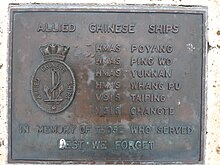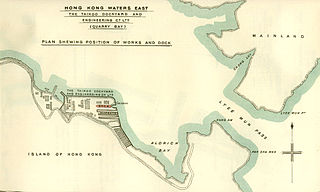
HMAS Vampire was a V-class destroyer of the Royal Navy (RN) and Royal Australian Navy (RAN). Launched in 1917 as HMS Wallace, the ship was renamed and commissioned into the RN later that year. Vampire was lent to the RAN in 1933, and operated as a depot tender until just before World War II. Reactivated for war service, the destroyer served in the Mediterranean as part of the Scrap Iron Flotilla, and was escorting the British warships HMS Prince of Wales and HMS Repulse during their loss to Japanese aircraft in the South China Sea in December 1941. Vampire was sunk on 9 April 1942 by Japanese aircraft while sailing with the aircraft carrier HMS Hermes from Trincomalee.

The China Navigation Company. Pte. Ltd. is registered in Singapore — with parent entity The China Navigation Company Limited (CNCo), trading as Swire Shipping & Swire Bulk — is a merchant shipping company based in Singapore. It is part of the Swire group, formerly John Swire and Sons.

HMS Activity was an escort carrier that served with the Royal Navy of the United Kingdom during the Second World War. After the war, she was sold into merchant service as the MV Breconshire, serving for over 20 years until scrapped in 1967.
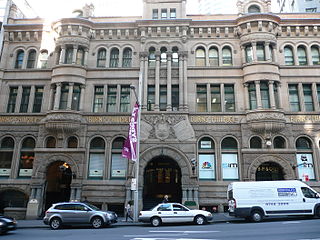
Burns Philp was once a major Australian shipping line and merchant that operated in the South Pacific. When the well-populated islands around New Guinea were targeted for blackbirding in the 1880s, a new rush for labour from these islands began. James Burns and Robert Philp purchased several well-known blackbirding ships to quickly exploit the human resource in this region, and Burns Philp entered the slave trade. The company ended its involvement in blackbirding in 1886. In later years the company was a major player in the food manufacturing business. Since its delisting from the Australian Securities Exchange in December 2006 and the subsequent sale of its assets, the company has mainly become a cashed up shell company. It is wholly owned by Graeme Hart's Rank Group.

A landing ship, infantry (LSI) or infantry landing ship was one of a number of types of British Commonwealth vessels used to transport landing craft and troops engaged in amphibious warfare during the Second World War. LSIs were operated by the Royal Navy, British Merchant Navy, Royal Canadian Navy, Royal Indian Navy, and Royal Australian Navy. They transported British Commonwealth and other Allied troops in sea assaults and invasions throughout the war.
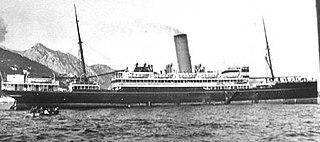
SS Zealandia, nicknamed "Z", was an Australian cargo and passenger steamship. She served as a troopship in both World War I and World War II. Zealandia transported the Australian 8th Division. Her crew were the last Allied personnel to see HMAS Sydney, which was lost with all hands in 1941. Zealandia was sunk in the air raids on Darwin of 19 February 1942.

Hong Kong and Whampoa Dock was a Hong Kong dockyard, once among the largest in Asia.

The Shoreham-class sloops were a class of eight warships of the Royal Navy built in the early 1930s.
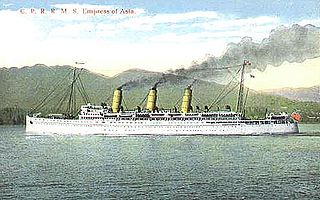
RMS Empress of Asia was an ocean liner built in 1912–1913 by Fairfield Shipbuilding and Engineering at Govan on the Clyde in Scotland for Canadian Pacific Steamships.
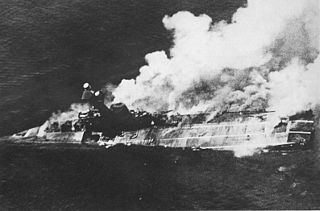
Prior to World War II, the Indian Ocean was an important maritime trade route between European nations and their colonial territories in East Africa, the Arabian Peninsula, British India, Indochina, the East Indies (Indonesia), and Australia for a long time. Naval presence was dominated by the Royal Navy Eastern Fleet and the Royal Australian Navy as World War II began, with a major portion of the Royal Netherlands Navy operating in the Dutch East Indies and the Red Sea Flotilla of the Italian Regia Marina operating from Massawa.

The Far East Combined Bureau, an outstation of the British Government Code and Cypher School, was set up in Hong Kong in March 1935, to monitor Japanese, and also Chinese and Russian (Soviet) intelligence and radio traffic. Later it moved to Singapore, Colombo (Ceylon), Kilindini (Kenya), then returned to Colombo.

HMAS Ping Wo was a 3,105 tons former Indo-Chinese river steamer that was commissioned into the Royal Australian Navy (RAN) during World War II. The Chinese name translates to "Equitable Harmony". It was one of a group of vessels known as the "China Fleet" acquired by the RAN in similar circumstances.

HMAS Whang Pu (FY-03) or SS Wang Phu was a 3,204 ton riverboat of the China Navigation Company that was commissioned into the Royal Australian Navy (RAN) in the Second World War. Her Chinese name translates to "Happy Times". She was one of a group of vessels called the "China Fleet" requisitioned for the RAN in similar circumstances.
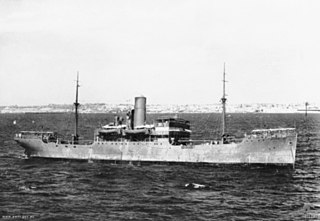
HMAS Poyang (FY-20) was a 2,873-ton former steamer that was commissioned into the Royal Australian Navy (RAN) during the Second World War. It was one of a group of vessels known as the "China Fleet", which were acquired by the RAN in similar circumstances.

SS Shuntien was a 3,059 GRT coastal passenger and cargo liner of the British-owned The China Navigation Company Ltd (CNC). She was built in Hong Kong in 1934 and sunk by enemy action in the Mediterranean Sea with great loss of life in 1941. A Royal Navy corvette rescued most of Shuntien's survivors, but a few hours later the corvette too was sunk and no-one survived.

HMS Salvia (K97) was a Flower-class corvette of the Royal Navy. She was ordered on the eve of the Second World War and entered service in September 1940. She rescued many survivors from the prison ship SS Shuntien when it was sunk on 23 December 1941. A few hours later, on Christmas Eve 1941, Salvia too was torpedoed. The corvette sank with all hands, and all of the survivors that she had rescued from Shuntien were also lost.
SS Hoihow was a British passenger ship built in 1933 in Hong Kong by the Taikoo Dockyard & Engineering Company of Hong Kong Ltd. in 1933 for The China Navigation Company of London to operate on the Indochina trade.

HMS Ladybird started life as MV Wusueh, a ferry built for the lower reaches of the YangtZe River between Shanghai and Hankow, operated by the China Navigation Company (CNCo), run by the British businessman John Samuel Swire. In 1941 she was requisitioned by the British Ministry of War Transport and used first as a troopship, then as a hospital ship, around Malaya and Burma. In 1946 she was returned to CNCo, refurbished and employed on the Hong Kong – Canton/Macao ferry service. In 1950, at the outbreak of the Korean War, the Royal Navy bought her, refitted her with communications equipment, renamed her HMS Ladybird and sent her to be moored at the US naval base at Sasebo, Japan, as the Naval Headquarters and Communications vessel for the Commonwealth Blockading forces. At the end of the war she was returned again to CNCo which sold her for breaking up.

